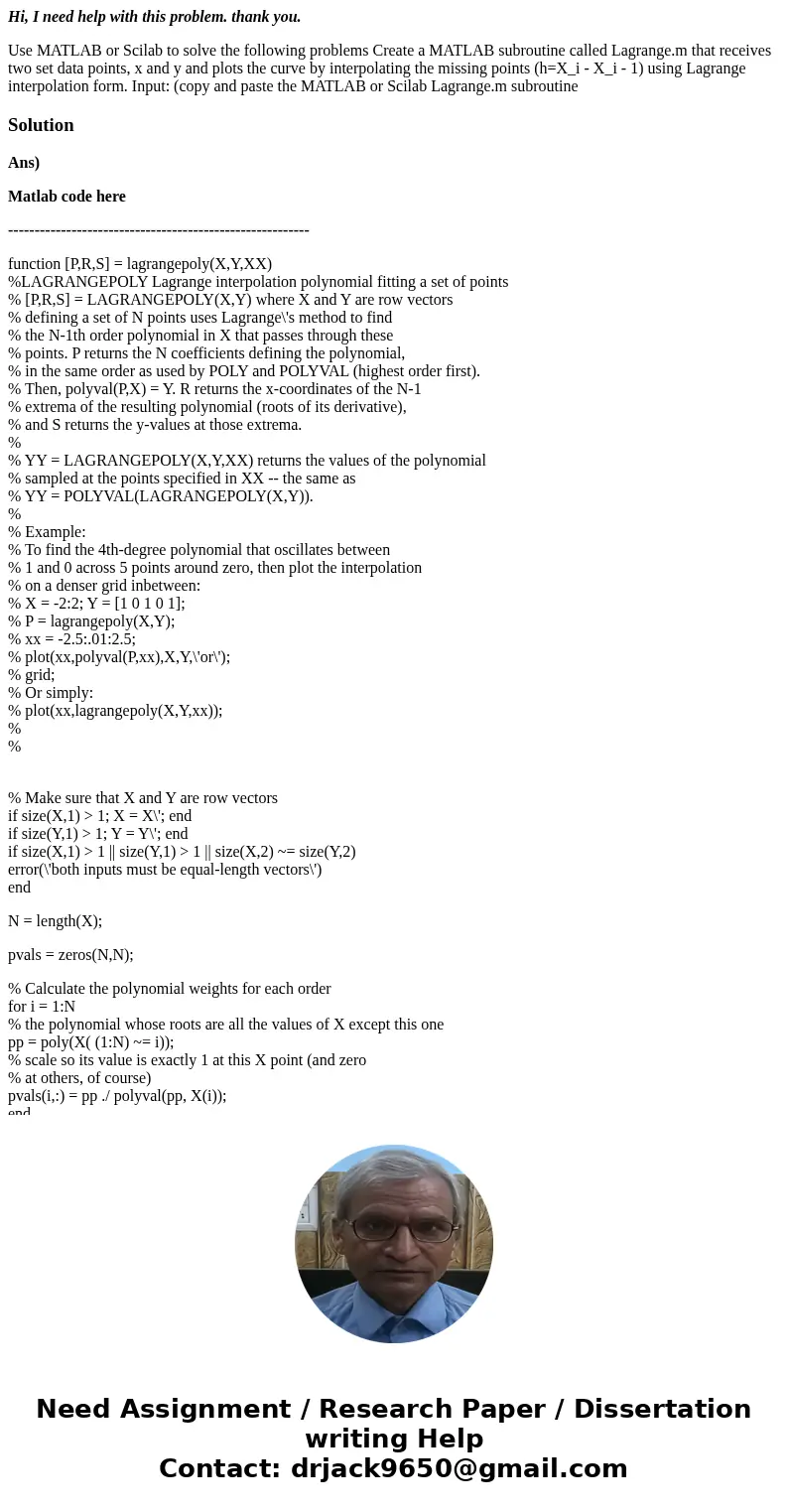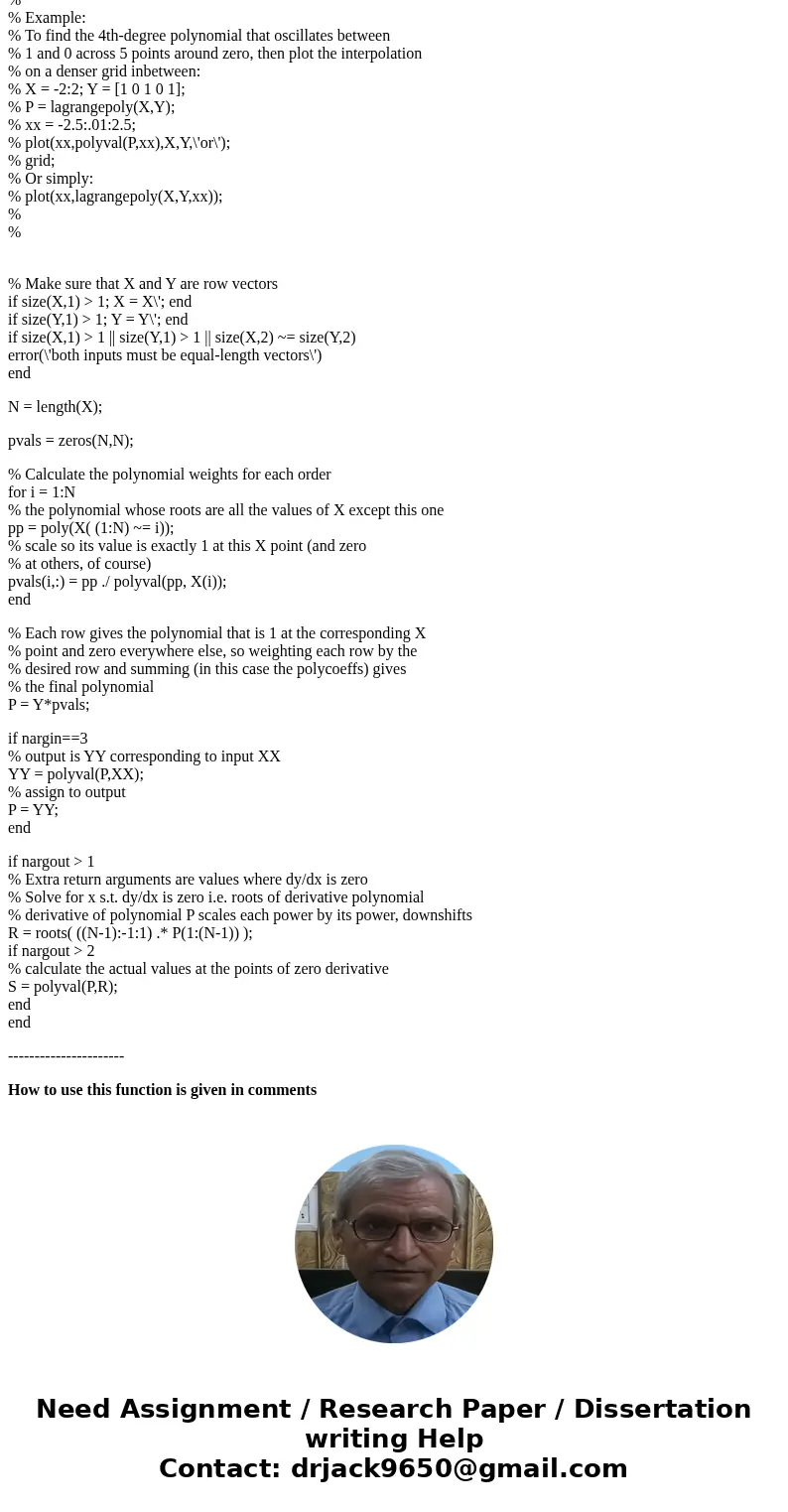Hi I need help with this problem thank you Use MATLAB or Sci
Hi, I need help with this problem. thank you.
Use MATLAB or Scilab to solve the following problems Create a MATLAB subroutine called Lagrange.m that receives two set data points, x and y and plots the curve by interpolating the missing points (h=X_i - X_i - 1) using Lagrange interpolation form. Input: (copy and paste the MATLAB or Scilab Lagrange.m subroutineSolution
Ans)
Matlab code here
---------------------------------------------------------
function [P,R,S] = lagrangepoly(X,Y,XX)
%LAGRANGEPOLY Lagrange interpolation polynomial fitting a set of points
% [P,R,S] = LAGRANGEPOLY(X,Y) where X and Y are row vectors
% defining a set of N points uses Lagrange\'s method to find
% the N-1th order polynomial in X that passes through these
% points. P returns the N coefficients defining the polynomial,
% in the same order as used by POLY and POLYVAL (highest order first).
% Then, polyval(P,X) = Y. R returns the x-coordinates of the N-1
% extrema of the resulting polynomial (roots of its derivative),
% and S returns the y-values at those extrema.
%
% YY = LAGRANGEPOLY(X,Y,XX) returns the values of the polynomial
% sampled at the points specified in XX -- the same as
% YY = POLYVAL(LAGRANGEPOLY(X,Y)).
%
% Example:
% To find the 4th-degree polynomial that oscillates between
% 1 and 0 across 5 points around zero, then plot the interpolation
% on a denser grid inbetween:
% X = -2:2; Y = [1 0 1 0 1];
% P = lagrangepoly(X,Y);
% xx = -2.5:.01:2.5;
% plot(xx,polyval(P,xx),X,Y,\'or\');
% grid;
% Or simply:
% plot(xx,lagrangepoly(X,Y,xx));
%
%
% Make sure that X and Y are row vectors
if size(X,1) > 1; X = X\'; end
if size(Y,1) > 1; Y = Y\'; end
if size(X,1) > 1 || size(Y,1) > 1 || size(X,2) ~= size(Y,2)
error(\'both inputs must be equal-length vectors\')
end
N = length(X);
pvals = zeros(N,N);
% Calculate the polynomial weights for each order
for i = 1:N
% the polynomial whose roots are all the values of X except this one
pp = poly(X( (1:N) ~= i));
% scale so its value is exactly 1 at this X point (and zero
% at others, of course)
pvals(i,:) = pp ./ polyval(pp, X(i));
end
% Each row gives the polynomial that is 1 at the corresponding X
% point and zero everywhere else, so weighting each row by the
% desired row and summing (in this case the polycoeffs) gives
% the final polynomial
P = Y*pvals;
if nargin==3
% output is YY corresponding to input XX
YY = polyval(P,XX);
% assign to output
P = YY;
end
if nargout > 1
% Extra return arguments are values where dy/dx is zero
% Solve for x s.t. dy/dx is zero i.e. roots of derivative polynomial
% derivative of polynomial P scales each power by its power, downshifts
R = roots( ((N-1):-1:1) .* P(1:(N-1)) );
if nargout > 2
% calculate the actual values at the points of zero derivative
S = polyval(P,R);
end
end
----------------------
How to use this function is given in comments


 Homework Sourse
Homework Sourse